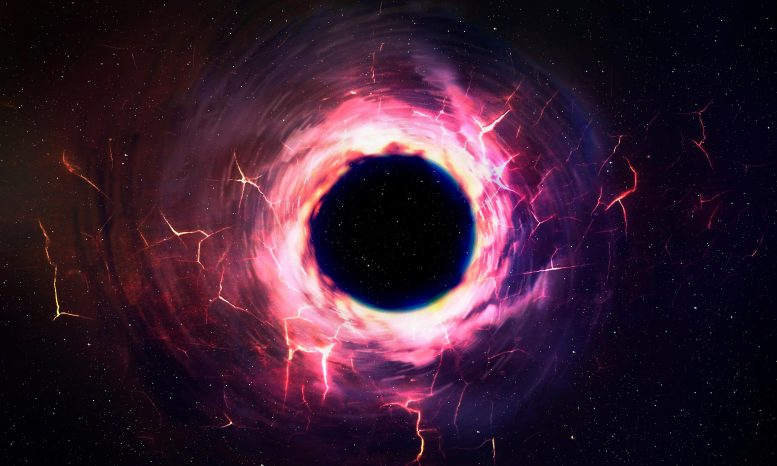
Colliding black holes produce multiple ‘chirps’ of gravitational waves, informing us about their shape and creating ripples in space-time.
A team of gravitational-wave scientists led by the ARC Centre of Excellence for Gravitational Wave Discovery (OzGrav) reveal that when two black holes collide and merge, the remnant black hole ‘chirps’ not once, but multiple times, emitting gravitational waves—intense ripples in the fabric space and time—that inform us about its shape. Today the study has been published in Communications Physics (from the prestigious Nature journal).
Black holes are one the most fascinating objects in the Universe. At their surface, known as the “event horizon,” gravity is so strong that not even light can escape from them. Usually, black holes are quiet, silent creatures that swallow anything getting too close to them; however, when two black holes collide and merge together, they produce one of the most catastrophic events in Universe: in a fraction of a second, a highly-deformed black hole is born and releases tremendous amounts of energy as it settles to its final form. This phenomenon gives astronomers a unique chance to observe rapidly changing black holes and explore gravity in its most extreme form.
Although colliding black holes do not produce light, astronomers can observe the detected gravitational waves — ripples in the fabric of space and time — that bounce off them. Scientists speculate that, after a collision, the behavior of the remnant black hole is key to understanding gravity and should be encoded in the emitted gravitational waves.
In the article published in Communications Physics (Nature), a team of scientists led by OzGrav alumnus Prof. Juan Calderón Bustillo — now ‘La Caixa Junior Leader – Marie Curie Fellow’ at the Galician Institute for High Energy Physics (Santiago de Compostela, Spain) — has revealed how gravitational waves encode the shape of merging black holes as they settle to their final form.
Graduate student and co-author Christopher Evans from the Georgia Institute of Technology (USA) says: “We performed simulations of black-hole collisions using supercomputers and then compared the rapidly changing shape of the remnant black hole to the gravitational waves it emits. We discovered that these signals are far more rich and complex than commonly thought, allowing us to learn more about the vastly changing shape of the final black hole.”
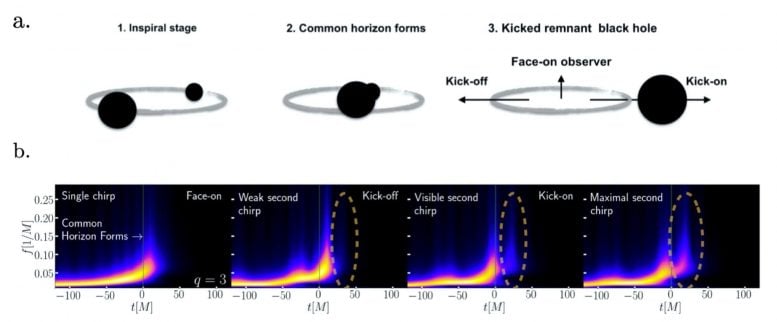
First, both black holes orbit each other, slowly approaching, during the inspiral stage. Second the two black holes merge, forming a distorted black hole. Finally, the black hole reaches its final form. b: Frequency of the gravitational-wave signals observed from the top of the collision (leftmost) and from various positions on its equator (rest) as a function of time. The first signal shows the typical “chirping” signal, in which the frequency raises as a function of time. The other three show that, after the collision (at t=0) the frequency drops and rises again, producing a second “chirp”. Credit: C. Evans, J. Calderón Bustillo
The gravitational waves from colliding black holes are very simple signals known as “chirps.” As the two black holes approach each other, they emit a signal of increasing frequency and amplitude that indicates the speed and radius of the orbit. According to Prof. Calderón Bustillo, “the pitch and amplitude of the signal increases as the two black holes approach faster and faster. After the collision, the final remnant black hole emits a signal with a constant pitch and decaying amplitude — like the sound of a bell being struck.” This principle is consistent with all gravitational-wave observations so far, when studying the collision from the top.
However, the study found something completely different happens if the collision is observed from the “equator” of the final black hole. “When we observed black holes from their equator, we found that the final black hole emits a more complex signal, with a pitch that goes up and down a few times before it dies,” explains Prof. Calderón Bustillo. “In other words, the black hole actually chirps several times.”
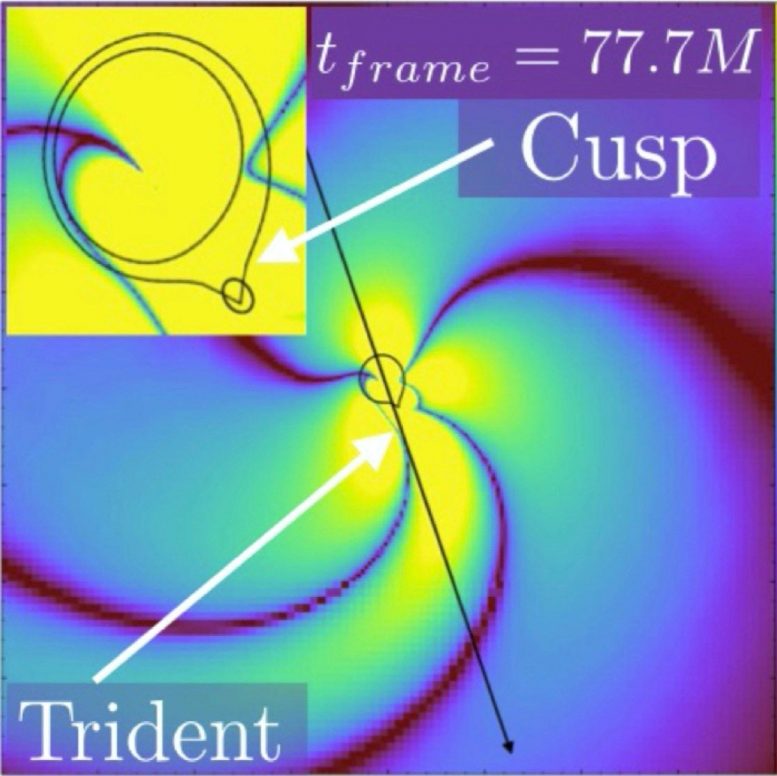
Detail of the shape of the remnant black hole after a black hole collision, with a ‘chestnut shape’. Regions of strong gravitational-wave emission (in yellow) cluster near its cusp. This black hole spins making the cusp point to all observers around it. Credit: C. Evans, J. Calderón Bustillo
The team discovered that this is related to the shape of the final black hole, which acts like a kind of gravitational-wave lighthouse: “When the two original, ‘parent’ black holes are of different sizes, the final black hole initially looks like a chestnut, with a cusp on one side and a wider, smoother back on the other,” says Bustillo. “It turns out that the black hole emits more intense gravitational waves through its most curved regions, which are those surrounding its cusp. This is because the remnant black hole is also spinning and its cusp and back repeatedly point to all observers, producing multiple chirps.”
Co-author Prof. Pablo Laguna, former chair of the School of Physics at Georgia Tech and now Professor at University of Texas at Austin, pointed out “while a relation between the gravitational waves and the behavior of the final black hole has been long conjectured, our study provides the first explicit example of this kind of relation.”
Reference: “Post-merger chirps from binary black holes as probes of the final black-hole horizon” by Juan Calderon Bustillo, Christopher Evans, James A. Clark, Grace Kim, Pablo Laguna and Deirdre Shoemaker, 8 October 2020, Communications Physics.
DOI: 10.1038/s42005-020-00446-7

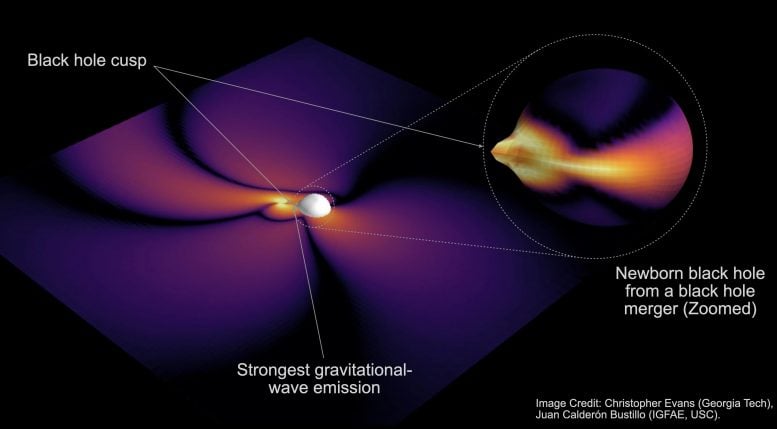




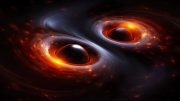


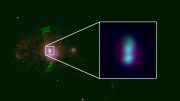
The artistic picture of a black hole in top of this article is not entirely correct. I observe white dots in the direct background of the black hole. In reality this is impossible because light can not escape from a black hole.
Further, compliments for the article, it was a nice and interesting snack to read.
light bends aournd mass, so yeah, you can see behind a bh
rendering for sure though
… space-time should have some properties, not like ether that was proven to be an illusion. Well, if it is an object what is its resonant frequency?
What are its properties that are not like unicorns mixed with marmade when it meets super man on steroids and looks from high high above onto explicable quantum world…
? General relativity, which both gravitational waves and black holes are based in, is founded upon the observation of that space and time are connected through the Lorentz transform. That is on top pf classical physics space as measured by rulers and time as measured by clocks (resonant systems).
Space and time are not objects as such, you need to observe them under cosmology to see them as an example of a system (object) under a process (of universal expansion).
I don’t understand what you mean by “its” resonant frequency here. How would the universe resonate? The universe is a product of inflation, and inflation gave the system 0 J energy (if space wasn’t already flat) and cooled the system to 0 K temperature and 0 J/K entropy. It was in (a frustrated) ground state and had no particles, no resonances in the quantum particle fields at the time. The – presumably local – universe that followed after inflation – presumably locally – ended has no global resonances. Thermodynamically it is under adiabatic free expansion, with little free energy to drive global resonances (as technically there is just a modern time TS temperature*entropy term which is insignificant).
Chirp, chirp.
The edge on events will be much less frequent – as we already seem to see – unfortunately. Oh, well.
…
“are not objects as such”, yeah not objects, … just empty stage, but there is no empty stage…
… Yeah, it will never resonate with you, I get it…
…
“Space and time are not objects as such”
yeah the stage is not empty, or is it a stage, or it is a philosophical concept of unknown properties that are just observed like ….
Yeah, it would not resonate with you, it need to resonate on something.
Ok, I’m just a sci-fi kinda geek, just like y’all, but instead of doing speculation theory work, use the skills you have and work with NASA, use your combined knowledge to come up with a hyperspace engine for space travel for future space missions, that’ll be awesome👍👍👍👍